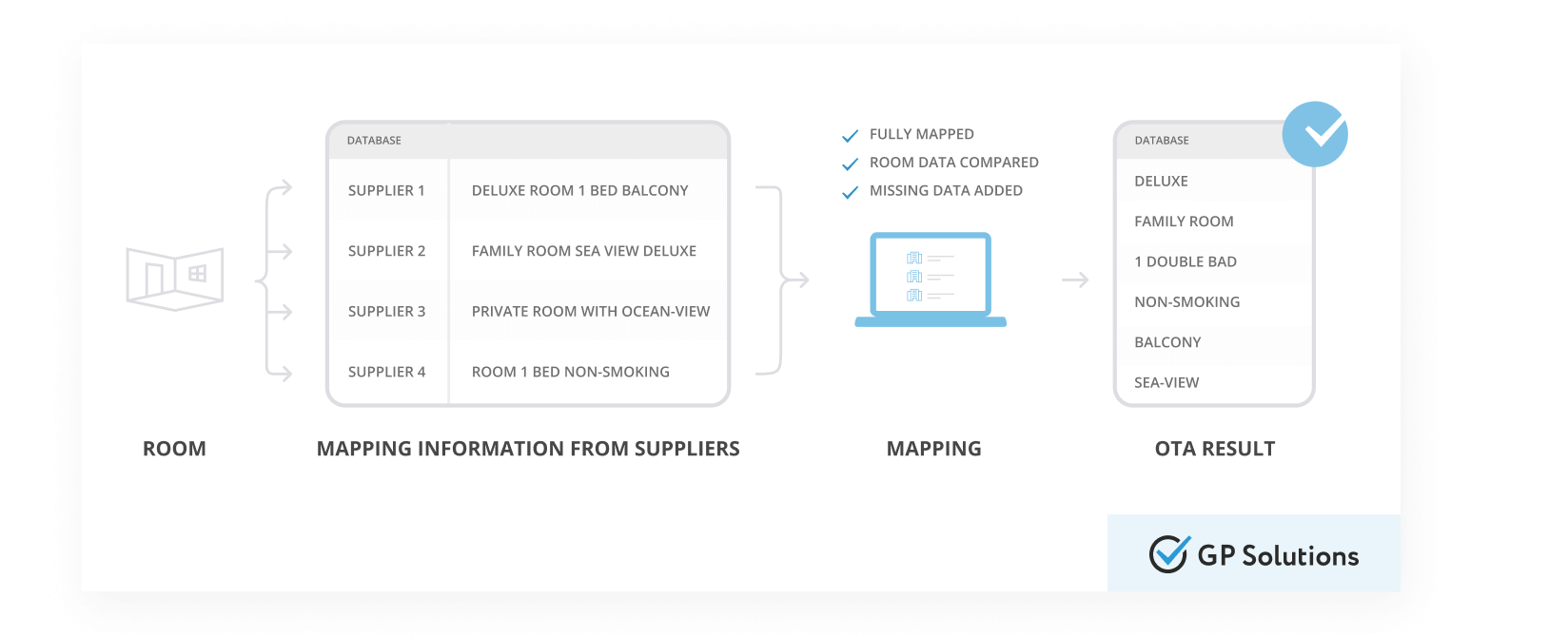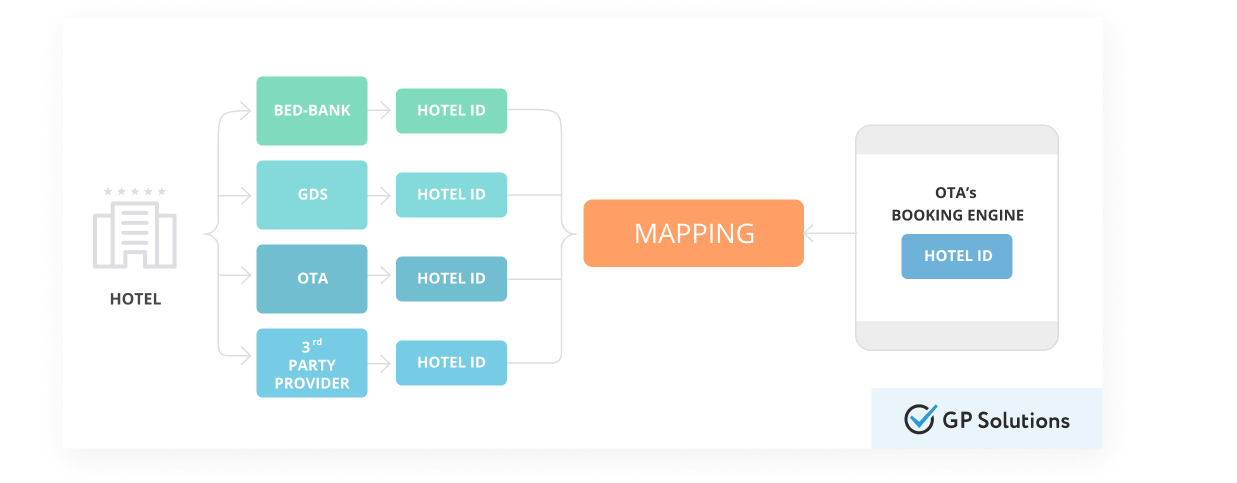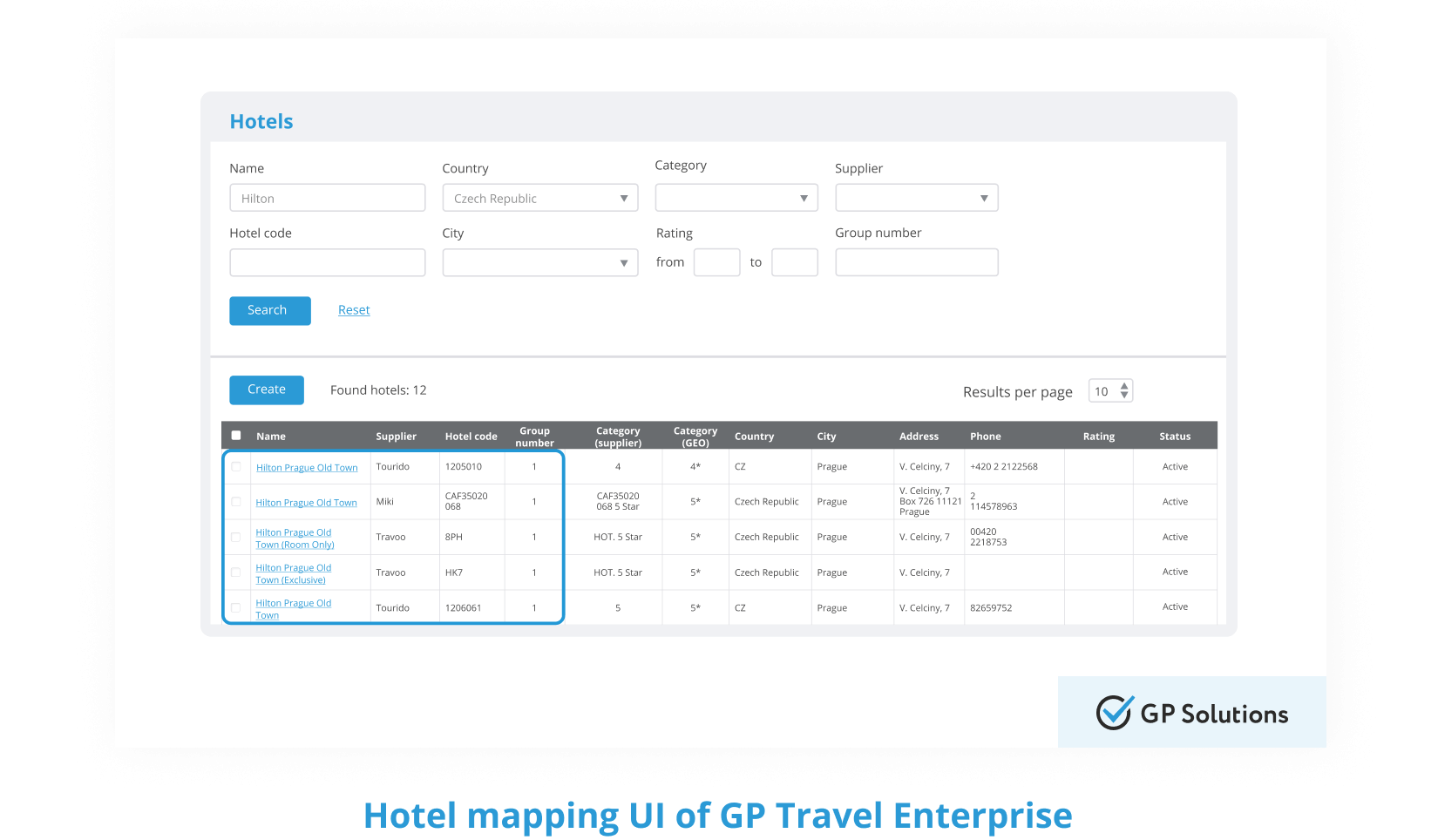- en
- de
Meet Us at Arabian Travel Market!
Meet Us at Arabian Travel Market!

The global market for online hotels distribution is packed with hundreds of suppliers. They differ by type (GDSs, bedbanks, hotel chains, etc.), depth of content coverage, geographic focus, etc. OTAs, tour operators and travel agents — the key providers of online hotel booking services — tend to contract a number of vendors simultaneously as they constantly chase better content and higher sales. With all its obvious advantages, such diversity of data sources may often backfire with data inconsistencies and duplication issues.
This may lead to one and the same hotel getting listed on a website several times — from different suppliers and in a different way. For example, in addition to ‘DoubleTree by Hilton London’ from Sabre, ‘London DoubleTree by Hilton’ may come up from Hotelbeds, ‘London DoubleTree’ from Webbeds — and what not. You can imagine how confused users can get when they find several ‘versions’ of the same hotel — with differences not only in the name but also in pricing, descriptions and many other things.
However, you don’t face issues like this too often on booking portals today. It is all thanks to the hidden matching processes commonly referred to as ‘mapping’ — a ‘must-have’ to ensure accurate and structured online hotel content. And while most travel professionals definitely heard the term, not all of them realize how the actual process works. Hope we can fill some gaps with this article.
To put it simply, mapping is all about aggregating large amounts of data from different sources in a clear and meaningful way. Besides the hospitality industry and travel, mapping techniques are frequently used in other industries whenever there’s a need for matching data from multiple sources.
Generally, the key purposes of mapping are:

As a result of mapping efforts, the end-users enjoy clear and well-arranged data without incorrect information or duplicates.
As for hotels and properties, mapping algorithms match all the descriptive content from various data sources into a single validated listing without inconsistencies. Currently, there are two distinct types of mapping distinguished on the market: hotel mapping and room-level mapping.
When a property is listed with several suppliers connected to the same OTA or tour operator, duplicate entries are fetched from them with unique supplier IDs assigned for each property. Hotel mapping merges these multiple property IDs from several hotel data suppliers into one to eliminate inconsistent naming and duplication in property listings.
Overall, hotel mapping handles the following property details:
If you want to combine pricing from several travel data suppliers on your website, you won’t go too far without hotel mapping.
While hotel mapping handles data structures and deduplication of general hotel details, room-level mapping is an extension designed to process other significant inventory-related content that is more specific. This content may include the following data:
and other details…
Even though hotel data mapping is more general compared to room mapping, they are both pretty similar and are based on pretty much the same principle. Room mapping algorithms analyze room data, optimize and clear duplicate content to ensure even more enhanced customer experience.
As already mentioned above, hotel and room mapping cater for proper structure, cleansing and deduplication of hotel data across multiple sources. However, no matter how eloquent you might be while explaining the importance of these processes, it can be hard to grasp unless you see a vivid example.
Here are a few illustrations. The schemes below demonstrate what mapping really does and what would hotel listings be without it:


As you can see, mapping is not only about inaccurate or duplicate names or texts. It can help to manage pricing, improve graphics, display valid room availability listings. It can also do a lot of other work that is invisible for the end-user and crucial to properly fine-tune your selling content.
Now as we’ve covered what mapping is and what it does, let us dig deeper into how it is implemented nowadays.
Currently, there are 3 basic approaches used to deliver mapping services:
This approach combines automated mapping with manual human effort. The process behind it is quite straightforward and is built of two steps:
Step 1. Pre-defined automatic mapping is applied for the hotel entries with equal names and addresses.
Step 2. An operator or a service team uses a specialized UI to manually review and set grouping for the hotels that didn’t get mapped automatically.
Semi-automated mapping is quite reliable and helps to build high-quality hotel listings. However, it may generate excessive manual effort in case too many hotel suppliers are connected simultaneously.
This technique is built around a simple UI that is used to upload hotel inventory files for matching. When uploaded, the user chooses hotel content distributors to map with. All the mapping processes are usually done automatically. Afterward the data is sent back to the customer.
Mapping as a service is more popular compared to the previous option as it normally doesn’t require manual work. This saves lots of time and effort.
This is by far the most popular mapping option nowadays. It is based around an API interface that needs to be integrated with the travel system where the mapping process takes place. The key benefit of API-based mapping is a permanent connection. It means there are permanent background processes updating the content and hotel ID database. However, it also requires some professional programming and appropriate resources to get the integration done.
Despite the high demand for mapping services, there are not too many reputable providers which offer commercial services of this sort. The ones that do provide it tend to use A.I., machine learning and other modern methods to minimize or totally eliminate manual work. On the whole manual mapping is more and more a thing of the past.
Let us take a closer look at some of the top contemporary mapping service suppliers.

Mapping by GIATA — an established company based in Germany — is partially automated using AI technology combined with machine learning. GIATA provides dynamic hotel mapping solutions using a universal property code — GIATA MultiCode. It also detects incorrect and duplicate data records in each database and corrects them.
GIATA delivers the following data via REST API:
The company also supplies a separate solution for room mapping. It is powered by an algorithm with the dictionary at its core which is updated as new room names are found. It focuses on the elements of room description and ignores elements that can be identified as a rate modifier (for ex., boarding type or cancellation terms).
The key data types covered by the room mapping solution include:

This company provides a fully automated cloud-based solution offering absolutely accurate data. With Gimmonix, the data is almost 99 percent accurate and takes only 24 hours to process. Gimmonix contains millions of properties in its database.
Mapping.Works is the brand name of the tool that is provided for hotel/room mapping. It does not require manual work.
The hotel mapping solution is based around an API integration or GUI where you upload a file with the hotel data process via FTP protocol. The room mapping implementation goes through an API along with a premium API service to check hotel room content.
Mapping.Works covers the following data:

DataBindR is another popular mapping provider. It has a cloud-based service that uses natural language processing and machine learning. There are two separate mapping solutions provided — HotelMappR and RoomBindR.
The first step to get your content mapped is HotelMappR. Your own hotel catalog must be uploaded as a CSV/EXCEL file to generate a mapped output file ready for integration. The hotel list is later handled via HotelBindR REST API. It processes key hotel information and forms a multi-lingual portfolio, if necessary.
Overall, the following information is covered:
The system goes through the data using machine learning, its own mathematical algorithms and deep learning. Based on the process output it assigns a hotel BindID. Room and hotel information is processed via separate APIs.
RoomMappR maps the following hotel room information and assigns it a unique BindID code:
Afterward, rooms are matched with the hotel portfolio. DataBindR claims to correct syntactic errors via specific algorithms designed for hospitality businesses. The vendor doesn’t use manual labor.
The clients can reuse all codes later, even when they stop using the solution. The system checks and cleans the data on its own.

UNICA by Vervotech is another SaaS provider of hotel mapping services using machine learning. It claims to map content with an accuracy of 99.99 percent. It covers 0.7 million hotels and 1.8 million apartments. The tool can operate the following hotel details:
UNICA can process not only general hotel details but also images, amenities, and other information. Besides, it analyzes the content quality and makes notes whenever some data is missing or invalid.
UNICA updates the content many times a day which allows it to supply real-time content. Its ‘Room Mapping’ module is delivered as part of ‘Hotel Mapping’ software or as a standalone solution.

Room-matching is a specialized mapping service supplier headquartered in Paris, France. It provides hotel ID mapping and room type matching services with extensive use of A.I. technology that ensures high productivity. In addition, room-matching uses NLP (Natural Language Processing) technology allowing to autocorrect descriptions, removing lingo, typos, etc. Currently, it can process content in 3 languages: English, Spanish and Portuguese.
Hotel ID mapping service
Hotel mapping solution is delivered as a SaaS service. It is supplier agnostic, with no installations or supplier credentials required. It works with a wide scope of data, including accommodations, attractions, businesses, etc. It is possible to receive the processed results on the fly in CSV or JSON, with email notifications when mapping is successfully made.
Room type matching
This service uses NLP and AI technologies. It is also supplier agnostic and works as 100% anonymous SaaS (the vendor doesn’t store any data provided by system users). Room type matching can work with the following room data:
In addition, the service provides room scoring functionality based on specific value adds (for ex., type, view, balcony, corner, etc.). The score ranges from 0 to 100 and is convenient for use in inventory sorting.
Besides specialized suppliers, built-in mapping solutions can be frequently found as part of travel automation systems supplied by different travel technology vendors. There is no need to go too far for example. The travel ERP system GP Travel Enterprise by GP Solutions provides its own UI hotel mapping. The platform also does partially automated mapping and integrates with 3rd-party mapping suppliers (for ex., GIATA, Room-matching.com).

To sum it all up, mapping today is a crucial element of any modern booking website. It basically has become an industry standard that removes many discrepancies and makes hotel data properly organized and intelligible for the end-user. Any travel company that is planning to build a travel portal and make use of multiple hotel data suppliers must certainly add a mapping solution to the «to-do list» if it isn’t still there. The connection process requires a certain level of technical skill, so it makes sense to find a technology vendor which can implement a bespoke integration. Unless of course, there are appropriate resources on your staff. It can also be a good plan to find a turnkey solution that has a working connection to a mapping supplier.
Hope this article was insightful and made hotel and room mapping much less of a mystery for you. Take a look at other articles in our blog for more quality travel technology content.
Looking for the best way to integrate a hotel mapping solution? — We can surely help you!

Leave your request
We will contact you shortly
Thank you for your request!
We will get back to you as quickly as possible
Get latest insights
from our travel tech experts!
Join 200+ travel fellows! Get GP Solutions' latest articles straight to your inbox. Enter your email address below:
Thank You!